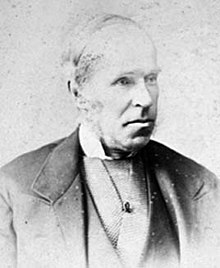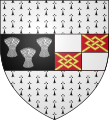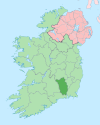Portal:County Kilkenny
The County Kilkenny Portal
County Kilkenny (Irish: Contae Chill Chainnigh) is a county in Ireland. It is in the province of Leinster and is part of the Southern Region. It is named after the city of Kilkenny. Kilkenny County Council is the local authority for the county. At the 2022 census the population of the county was 103,685. The county was based on the historic Gaelic kingdom of Ossory (Osraighe), which was coterminous with the Diocese of Ossory. (Full article...)
Selected articles

Kilkenny (Irish: Cill Chainnigh [ˌciːl̠ʲ ˈxan̠ʲəj], meaning 'church of Cainnech') is a city in County Kilkenny, Ireland. It is located in the South-East Region and in the province of Leinster. It is built on both banks of the River Nore. The 2022 census gave the population of Kilkenny as 27,184, the thirteenth-largest urban center in Ireland.
Kilkenny is a tourist destination, and its environs include historic buildings such as Kilkenny Castle, St Canice's Cathedral and round tower, Rothe House, Shee Alms House, Black Abbey, St. Mary's Cathedral, The Tholsel, St. Francis Abbey, Grace's Castle, and St. John's Priory. Kilkenny is also known for its craft and design workshops, the Watergate Theatre, public gardens and museums. Annual events include Kilkenny Arts Festival, the Cat Laughs comedy festival and music at the Kilkenny Roots Festival.
Kilkenny began with an early 6th-century ecclesiastical foundation within the Kingdom of Ossory. Following the 12th-century Norman invasion of Ireland, Kilkenny Castle and a series of walls were built to protect the burghers of what became a Norman merchant town. William Marshall, Lord of Leinster, gave Kilkenny a charter as a town in 1207. By the late 13th century, Kilkenny was under Hiberno-Norman control. The Statutes of Kilkenny, passed at Kilkenny in 1367, aimed to curb the decline of the Hiberno-Norman Lordship of Ireland. In 1609, King James I of England granted Kilkenny a Royal Charter, giving it the status of a city. Following the Irish Rebellion of 1641, the Irish Catholic Confederation, also known as the "Confederation of Kilkenny", was based in Kilkenny and lasted until the Cromwellian conquest of Ireland in 1649. From 1840 onwards, Kilkenny has not been administered as a city under local government law, but the Local Government Reform Act 2014 provides for "the continued use of the description city". (Full article...)
Selected history articles
The Kilkenny Archaeological Society is an archaeological society in County Kilkenny, Ireland. (Full article...)
Selected landmarks articles

The Church of Saint John the Evangelist, or John's Church, is a Gothic Revival style church in Kilkenny, Ireland. The Church was designed by William Hague and built from 1903 to 1908 on the site of an earlier church located in the graveyard. The grounds contain a trees and greenery. (Full article...)
Selected geography articles
Kilkenny (Irish: Cill Chainnigh [ˌciːl̠ʲ ˈxan̠ʲəj], meaning 'church of Cainnech') is a city in County Kilkenny, Ireland. It is located in the South-East Region and in the province of Leinster. It is built on both banks of the River Nore. The 2022 census gave the population of Kilkenny as 27,184, the thirteenth-largest urban center in Ireland. (Full article...)
Thomastown may refer to: (Full article...)
The River Nore (Irish: An Fheoir [ə ˈn̠ʲoːɾʲ]) is one of the principal rivers (along with the River Suir and River Barrow) in the South-East Region of Ireland. The 140-kilometre-long (87 mi) river drains approximately 2,530 square kilometres (977 sq mi) of Leinster and Munster, that encompasses parts of three counties (Tipperary, Laois, Kilkenny). Along with the River Suir and River Barrow, it is one of the constituent rivers of the group known as the Three Sisters. (Full article...)
The South Leinster Way is a long-distance trail in Ireland. It is 104 kilometres (65 miles) long and begins in Kildavin, County Carlow and runs through County Kilkenny before ending in Carrick-on-Suir, County Tipperary. It is typically completed in five days. It is designated as a National Waymarked Trail by the National Trails Office of the Irish Sports Council and is jointly managed by Carlow County Council, Kilkenny County Council, Tipperary County Council, Carlow Local Sports Partnership, Kilkenny Trails and Coillte. It was opened on 30 November 1985 by Donal Creed, Minister of State for Sport. (Full article...)
Selected quotation
"Fire without smoke, Air without fog, Water without mud, Land without bog."
|
— Unknown, circa 17th Century |
Selected Did you know

- ... that Blessed Edmund Ignatius Rice was the founder of two institutes of religious brothers, the Congregation of Christian Brothers and the Presentation Brothers.?
- ... that the Statutes of Kilkenny were a series of thirty-five acts passed at Kilkenny in 1366, aiming to curb the decline of the Hiberno-Norman Lordship of Ireland. (Full article...)
Selected slideshow image
Selected biography articles

John Casey (12 May 1820, Kilbehenny, County Limerick, Ireland – 3 January 1891, Dublin) was a respected Irish geometer. He is most famous for Casey's theorem on a circle that is tangent to four other circles, an extension of Ptolemy's theorem. However, he contributed several novel proofs and perspectives on Euclidean geometry. He and Émile Lemoine are considered to be the co-founders of the modern geometry of the circle and the triangle. (Full article...)
Abraham Colles (23 July 1773 – 16 November 1843) was Professor of Anatomy, Surgery and Physiology at the Royal College of Surgeons in Ireland (RCSI) and the President of RCSI in 1802 and 1830. A prestigious Colles Medal & Travelling Fellowship in Surgery is awarded competitively annually to an Irish surgical trainee embarking on higher specialist training abroad before returning to establish practice in Ireland. (Full article...)
Kathleen Marescaux (3 July 1868 – 14 April 1944), born Kathleen Louisa Rose Dennis, was an Irish artist, best known as a painter of botanical subjects and rural landscapes. (Full article...)
Hubert Marshal Butler (23 October 1900 – 5 January 1991) was an Irish essayist who wrote on a wide range of topics, from local history and archaeology to the political and religious affairs of eastern Europe before and during World War II. He also travelled to Nazi Austria on his own initiative and at his own expense and helped save Jews from being sent to concentration camps. (Full article...)
Selected sport articles
Angela Downey-Browne (born 1957, Kilkenny) is a retired Irish sportsperson. She played camogie with her local clubs, St Paul's based in Kilkenny city and Lisdowney, and was a member of the Kilkenny senior inter-county team from 1970-95. Downey is regarded as the greatest player in the history of the game.
In a senior inter-county career that 25 years she won twelve All-Ireland medals, thirteen Leinster medals and eight National League medals. With her two clubs St. Paul's and Lisdowney she collected 22 county titles and 6 All-Ireland club medals. (Full article...)
Related portals
Associated Wikimedia
The following Wikimedia Foundation sister projects provide more on this subject:
-
Commons
Free media repository -
Wikibooks
Free textbooks and manuals -
Wikidata
Free knowledge base -
Wikinews
Free-content news -
Wikiquote
Collection of quotations -
Wikisource
Free-content library -
Wikiversity
Free learning tools -
Wikivoyage
Free travel guide -
Wiktionary
Dictionary and thesaurus






























































